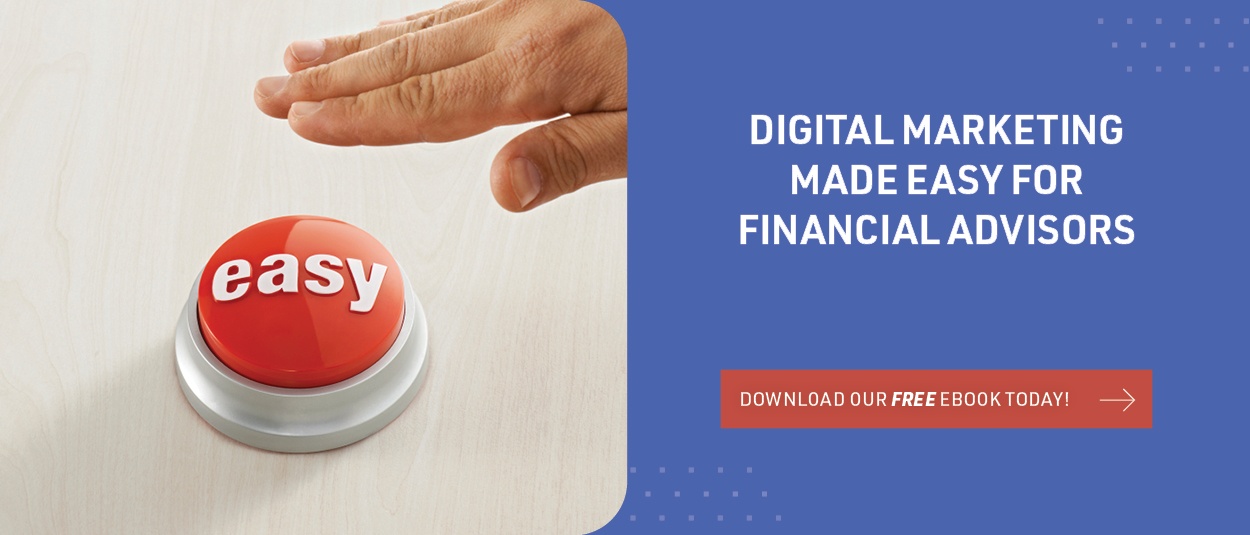

Financial Advisor Marketing: 5 Tips For Converting Prospects Into Clients
Let’s assume the investor uses the Internet to find, screen, and contact financial advisors. Investors become financial advisor leads when they submit their contact information. Leads become prospects when there has been contact and there is a mutual level of interest.
62% of investors use geo-specific keywords to find firms and professionals who work in their communities. Part of successful financial advisor marketing includes a local SEO strategy, including the use of geo-specific words on your website and other content.
Once the investors find advisors they use the Internet to research the professionals’ credentials, ethics, business practices, and services. 82% of investors will visit financial advisor websites to learn more. 64% will Google search the financial advisors’ names to learn even more.
The results of their searches for information will determine who the investors contact to schedule interviews. At this stage, the investor becomes a qualified lead for financial advisors.
Think of this as a process of exclusion (8:4:1). Investors visit eight websites, contact four for interviews, and select one to be their financial advisor. The process of going from eight to one will vary by investor, but the goal of the financial advisor remains the same at each stage - don’t get excluded.
How can you increase the probability that these investors become leads that you can turn into revenue-producing clients?
Read 5 Tips that are a proven process for converting more financial advisor leads into prospects and clients.
1. Your first impression on the Internet is a critical first step.
The Internet is a game-changer. In the old days, your initial point of contact was a telemarketing call that you controlled.
In modern times investors initiate contact by sending you an email or a text message. Most importantly, the Investors remain anonymous until they are ready to be contacted.
Your first impression is what they see when they Google search your name and visit your website. Your initial messaging, above the fold, has to make this impression.
You must make that first impression as positive as possible – there are no second chances on the Internet. If you fail to capture the investors’ interest, you just become one of the eight that are not contacted by the investors.
You have ten seconds or less to create this first impression: Your name, a professional logo, a convincing elevator pitch, and some informative text so the investors know they came to the right website.
Paladin Tip: Keep investors on your website for three minutes or more.
2. Establishing your online credibility is an important next step.
Investors are looking for experts that can help them achieve their financial goals. Consequently, every financial advisor and sales representative claims to be a financial expert.
You need an online content strategy that proves you are an expert. Consider these three types of proof:
- When investors Google search your name, they should see substantial content you have written that is published on the Internet.
- Your website, and your Our Team profile, should provide information that documents your claim for being an expert: Degrees, experience, certifications, and continuing education.
- You may want to use testimonials and reviews to support your claims of being a financial expert.
Paladin Tip: Regardless of the size of your firm, most investors are selecting professionals to be their personal advisors.
3. Building trust on the Internet
Not only are investors looking for experts, they are looking for experts they can trust. So, how do you prove you are trustworthy? The most frequently used tactics are to:
- Provide a link to FINRA/BrokerCheck with your CRD number
- Verify in writing you are a financial fiduciary
- Provide a strict Code of Ethics on your website that you agree to abide by
- Use testimonials and reviews that document trustworthiness
Paladin Tip: Proof of trustworthiness should not look promotional.
4. Describe your differentiating characteristics.
Do not assume investors will figure out differentiating characteristics on their own. All too often, they believe all advisors are the same - that is, the same services, same fees, same processes, same software, etc. This could be based on the content of sales pitches.
This means it is up to you to describe the characteristics that differentiate your firm from other advisors. The five most important characteristics are your:
- Credentials (Education, Experience, Certifications)
- Fiduciary status (RIA or IAR)
- Compensation (Fees)
- Compliance record (No disclosures)
- Investor-friendly business practices
Paladin Tip: Differentiation makes your sales process that much easier when the differences have a positive impact on investors.
5. Practice full transparency for information that benefits investors.
Documentation can be your friend if you are a high-quality financial advisor with nothing to hide. Documentation can be your enemy if you are an advisor with something to hide.
Low-quality advisors use sales pitches and undocumented sales claims to gain control of investor assets. The common denominator is that all of their information is verbal which is contained in their pitches. They want to be hired based on what they say and their personalities.
Lower-quality advisors are resistant to documentation because it creates a written record that makes them less competitive. On the other hand, making documentation a selection criterion can benefit higher-quality financial advisors.
Knowledgeable investors want a written record of what was said to them in case there is a future dispute.
An illustration of transparency is your method and amount of compensation: Fee-only, fee and commission, commission only. Do you publish a fee schedule on your website? Or, do you publish how you are compensated on your website, but not the amount? Some form of disclosure is a good idea.
Paladin Tip: If you have nothing to hide, you should be using documentation to separate you and your services from competitors that cannot afford to practice full transparency. Be sure to point this out on your website.

Jack Waymire, BA, MBA
Search Here
Categories
- AI (18)
- blogging (2)
- branding (1)
- content (12)
- custodians (1)
- Digital (345)
- email marketing (3)
- fcmo (2)
- fees (1)
- financial advisor marketing (62)
- Google (3)
- Ideas & Tips (78)
- Investor Experience (7)
- lead generation (7)
- linkedin (1)
- Marketing (371)
- newsletters (1)
- Online Transparency (2)
- search engine optimization (3)
- seo (9)
- Social Media (2)
- video (2)
- Websites (108)
- YouTube channel (2)
Recent Posts
-

-

How Financial Advisor Blogging Generates Thought Leadership and Leads
November 24, 2025 -

Top 5 Ways Digital Marketing Benefits Financial Advisors Seeking Leads
November 20, 2025 -

Trust Is The Biggest Online Marketing Challenge For Financial Advisors
November 17, 2025 -

Compliant Financial Advisor Bios Using AI Website Builders
October 22, 2025

